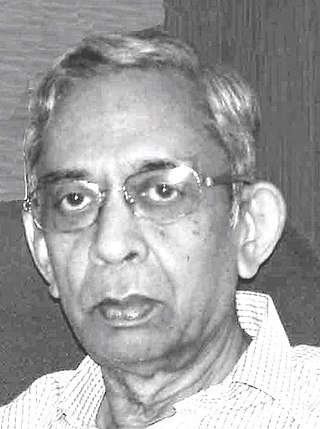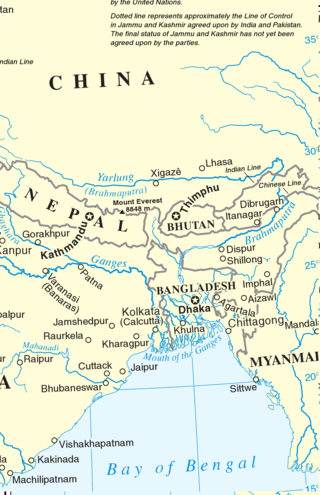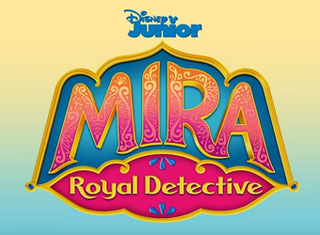Censorship in South Asia can apply to books, movies, the Internet and other media. Censorship occurs on religious, moral and political grounds, which is controversial in itself as the latter especially is seen as contrary to the tenets of democracy, in terms of freedom of speech and the right to freely criticise the government.

The Bay of Bengal Initiative for Multi-Sectoral Technical and Economic Cooperation (BIMSTEC) is an international organisation of seven South Asian and Southeast Asian nations, housing 1.73 billion people and having a combined gross domestic product of US$5.2 trillion (2023). The BIMSTEC member states – Bangladesh, Bhutan, India, Myanmar, Nepal, Sri Lanka, and Thailand – are among the countries dependent on the Bay of Bengal.
Das is a common last name in South Asia, among adherents of Hinduism and Sikhism, as well as those who converted to Islam or Christianity. It is a derived from the Sanskrit word Dasa meaning servant, devotee, or votary. "Das" may be inferred to be one who has surrendered to God. The surname is often used by those in the Vaishnav community.

Bengalis, also rendered as Bangalee, are an Indo-Aryan ethnolinguistic group originating from and culturally affiliated with the Bengal region of South Asia. The current population is divided between the sovereign country Bangladesh and the Indian states of West Bengal and Tripura, Barak Valley, Andaman and Nicobar Islands, Jharkhand and part of Meghalaya and Manipur. Most speak Bengali, a language from the Indo-Aryan language family.
Future Thought Productions is a creative animation studio that creates, produces or contributes to film, television, web and mobile animation.

South Asian cinema refers to the cinema of Afghanistan, Bangladesh, Bhutan, India, Maldives, Nepal, Pakistan and Sri Lanka. The broader terms Asian cinema, Eastern cinema and Oriental cinema in common usage often encompass South Asia as well as East Asia and Southeast Asia.

Ssshhhh... Koi Hai is an Indian horror thriller television anthology series created by Cinevistaas Limited and Contiloe Entertainment for Star Plus. The first season was created by them together, while later seasons were only created by Abhimanyu Raj Singh and were aired on Star Plus' sister channel Star One. The series which premiered on 27 July 2001, ran for three seasons ending on 16 May 2010.

South Asia is the southern subregion of Asia, which is defined in both geographical and ethnic-cultural terms. As commonly conceptualized, the modern states of South Asia include Afghanistan, Bangladesh, Bhutan, India, Maldives, Nepal, Pakistan, and Sri Lanka. South Asia borders East Asia to the northeast, Central Asia to the northwest, West Asia to the west and Southeast Asia to the east. Topographically, it is dominated by the Indian subcontinent and is bounded by the Indian Ocean in the south, and the Himalayas, Karakoram, and Pamir Mountains in the north.

Ram Mohan was an Indian animator, title designer and design educator, who was also known as father of Indian Animation and was a veteran in the Indian animation industry, who started his career at the Cartoon Films Unit, Films Division of India, Government of India in 1956. He was chairman and chief creative officer at Graphiti Multimedia, a Mumbai-based animation company which was established in 1995, and later he also established the Graphiti School of Animation in 2006.

Bengali Americans are Americans of Bengali ethnic, cultural and linguistic heritage and identity. They trace their ancestry to the historic ethnolinguistic region of Bengal region in the Indian subcontinent, now divided in South Asia between Bangladesh and West Bengal of India. Bengali Americans are also a subgroup of modern-day Bangladeshi Americans and Indian Americans. Bengalis are also classified under Bangladeshi Americans. Significant immigration of Bengalis to the United States started after 1965.

Poramon is a 2013 Bangladeshi Bengali romantic drama film directed by Jakir Hossain Raju and written by Farzana. It is distributed by Jaaz Multimedia. It stars Symon Sadik and Mahiya Mahi. A stand alone sequel Poramon 2 was released on 16 June 2018.
Bangladeshi English literature (BEL) refers to the body of literary work written in the English language in Bangladesh and the Bangladeshi diaspora. In academia, it is also now referred to as Bangladeshi Writing in English (BWE). Early prominent Bengali writers in English included Ram Muhan Roy, Bankim Chandra Chatterjee, Begum Rokeya and Rabindranath Tagore. In 1905, Begum Rokeya (1880–1932) wrote Sultana's Dream, one of the world's earliest examples of feminist science fiction. Modern writers of the Bangladeshi diaspora include Tahmima Anam, Neamat Imam, Monica Ali and Zia Haider Rahman.

The South Asia Subregional Economic Cooperation (SASEC) Program, set up in 2001, brings together Bangladesh, Bhutan, India, Maldives, Myanmar, Nepal, and Sri Lanka in a project-based partnership to promote regional prosperity by improving cross-border connectivity, boosting trade among member countries, and strengthening regional economic cooperation. As of June 2020, SASEC countries have implemented 61 regional projects worth over $13 billion in the energy, transport, trade facilitation, economic corridor development, and information and communications technology (ICT) sectors. The Manila, Philippines-based Asian Development Bank (ADB) serves as the Secretariat for the SASEC member countries.
Ali Riaz is a Bangladeshi American political scientist and writer. He is a Distinguished Professor at Illinois State University where he joined in 2002. Most of his work deals with religion and politics, particularly on South Asian politics and political Islam. He has written extensively on Bangladeshi politics and madrasas in South Asia. He was the editor of Studies on Asia, a bi-annual journal of the Midwestern Conference on Asian Affairs (2010–2015). He was also a public policy scholar at the Woodrow Wilson International Center for Scholars at Washington DC during the Fall of 2013. He is a non-resident senior fellow with the South Asia Center of the Atlantic Council.

Eastern South Asia is a geographical area in the Southern Asian subregion, precisely the eastern region of the subcontinent. It includes the countries of Bangladesh, Bhutan, Nepal and India. Geographically, it lies between the Eastern Himalayas and the Bay of Bengal. Two of the world's largest rivers, the Ganges and the Brahmaputra, flow into the sea through the Bengal region. The region includes the world's highest mountainous terrain and the world's largest delta, and has a climate ranging from alpine and subalpine to subtropical and tropical. Since Nepal, Bhutan, and northeast India are landlocked, the coastlines of Bangladesh and East India serve as the principal gateways to the region.
Mithu Sen is an Indian conceptual artist. Born in West Bengal in 1971.

Mira, Royal Detective is an American CGI-animated mystery children's television series produced by Wild Canary Animation, which is inspired by Indian culture and customs. The show's protagonist, Mira, is the first Indian protagonist in a Disney Junior show. It debuted on Disney Junior channel and programming block in United States on March 20, 2020, and in Canada on March 22, 2020.
UNICEF Meena Media Award, more popularly known as the Meena Media Award, are awards for outstanding contribution on promoting children's issues in print, online and broadcast media since 2005.
Maria Manda Sangma is a Bangladeshi professional women's footballer who plays as a midfielder for both the Bangladesh Women's Football League club Bashundhara Kings Women and the Bangladesh women's national football team. Previously she played for the Kalsindur High School team in Mymensingh. She was a member of the Bangladesh Under-14 team that won the 2015 AFC U-14 Women's Regional Championship - South and Central in Nepal and the 2016 AFC U-14 Women's Regional Championship - South and Central in Tajikistan. As a defensive midfield player, she played in the 2017 AFC U-16 Women's Championship qualification which held in Dhaka, Bangladesh under Bangladesh U16.
Sub-regional Co-operation Cell is a Bangladesh government agency under the Prime Minister's Office. It is responsible for managing relationship in the Bangladesh, Bhutan, India, Nepal sub regional initiative.










